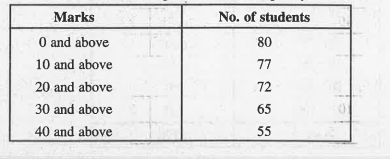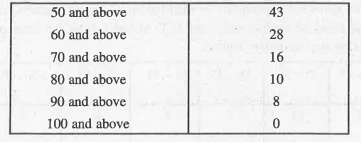If Im=∫(sinx+cosx)mdx, then show that mlm=(sinx+cosx)m−1⋅(sinx−cosx)+2(m−1)Im−2Solution in Punjabi
I4,2=16(−sin3xcos3x+3I2,2)
I4,2=16(sin3xcos3x+3I2,2)
I4,2=16(sin3xcos3x−3I2,2)
I4,2=14(−sin3xcos3x+2I2,2)
The correct Answer is:A
Step by step video & image solution for If I_(m)=int (sin x+cos x)^(m)dx, then show that m l_(m)=(sin x+ cos x)^(m-1)*(sin x- cos x)+2(m-1) I_(m-2) by Maths experts to help you in doubts & scoring excellent marks in Class 12 exams.
Updated on:21/07/2023Topper's Solved these Questions
- INDEFINITE INTEGRAL BOOK - ARIHANT MATHSCHAPTER - INDEFINITE INTEGRAL EXERCISE - Exercise 5 ( Matching Type Questions )
2 Videos
- INDEFINITE INTEGRAL BOOK - ARIHANT MATHSCHAPTER - INDEFINITE INTEGRAL EXERCISE - Exercise (Single Integer Answer Type Questions)
9 Videos
- INDEFINITE INTEGRAL BOOK - ARIHANT MATHSCHAPTER - INDEFINITE INTEGRAL EXERCISE - Exercise (Statement I And Ii Type Questions)
5 Videos
- HYPERBOLABOOK - ARIHANT MATHSCHAPTER - HYPERBOLAEXERCISE - Hyperbola Exercise 11 : Questions Asked in Previous 13 Years Exams
3 Videos
- INVERSE TRIGONOMETRIC FUNCTIONSBOOK - ARIHANT MATHSCHAPTER - INVERSE TRIGONOMETRIC FUNCTIONSEXERCISE - Exercise (Questions Asked In Previous 13 Years Exam)
8 Videos
Similar Questions
Find the mean marks of the following cummulative frequency table :


View SolutionIf ∫(2x+3)dxx(x+1)(x+2)(x+3)+1=C−1f(x) where f(x) is of the form of ax2+bx+c, then(a+b+c) equals to …….
View SolutionSolve dydx+yx=logx.
View Solutionwhich term of the following sequence : 312,3,332.....is 81?
View SolutionIf α=3sin−1(611andβ=3cos−1(49), where the inverse trigonometric functions take only the principal values, then the correct options (s) is (are)
View SolutionIf I_(m,n)=int cos^(m)x sin nxdx=f(m,n)I_(m-1)-(cos^(m)x cos nx)/(m+n), then f(m,n)=
View SolutionComprehension 1
Let In,m=∫sinnxcosmx.dx. Then we can relate In,m with each of the following
i) In−2,m, ii) In+2,m, iii) In,m−2
iv) In,m−2, v) In−2,m+2, vi) In+2,m−2
Suppose we want to establish a relation between In,m and In,m−2, then we set
P(x)=sinn+1xcosm−1x................(1)
In In,m and In,m−2 the exponent of cosx is m and m−2+1=m−1. Now choose the exponent m−1 of cosx in P(x). Similarly choose hte exponent of sinx for P(x).
Now, differentiating both sides of (1), we get
P′(x)=(n+1)sinnxcosmX−(m−1)sinn+2Xcosm−2X
=(n+1)sinnXcosmX−(m−1)sinnx(1−cos2x)cosm−2X
=(n+1)sinnXcosmX−(m−1)sinnXcosm−2X+(m−1)sinnXcosmX
=(n+m)sinnXcosmX−(m−1)sinnXcosm−2X
Now, integrating both sides, we get
sinn+1cosm−1x=(n+m)In,m−(m−1)In,m+2
Similarly, we can establish the other relations.
The relation between I4,2 and I2,2 is
View SolutionIf m and M are the least and the greatest value of (cos−1x)2+(sin−1x)2 , then Mm is equal to
View Solution∫sinmxcosm+2xdx=
View SolutionIf Im=∫(sinx+cosx)mdx, then show that mlm=(sinx+cosx)m−1⋅(sinx−cosx)+2(m−1)Im−2
View SolutionIf Im,n=∫cosmx⋅cosnxdx, show that (m+n)Im,n=cosmx⋅sinnx+mI(m−1,n−1)
View SolutionLet Im,n=∫sinnxcosmxdx. Then , we can relate In,m with each of the following :
(i) In−2,m (ii)In+2,m
(iii) In,m−2 (iv)In,m+2
(v) In−2,m+2 In+2,m−2
Suppose we want to establish a relation between In,m and In,m−2, then we get
P(x)=sinn+1xcosm−1x ...(i)
In In,m and In,m−2 the exponent of cos x in m and m−2 respectively, the minimum of the two is m - 2, adding 1 to the minimum we get m−2+1=m−1. Now, choose the exponent of sin x for m - 1 of cos x in P(x). Similarly, choose the exponent of sin x for
P(x)=(nH)sinnxcosmx−(m−1)sinn+2xcosm−2x.
Now, differentiating both the sides of Eq. (i), we get
=(n+1)sinnxcosmx−(m−1)sinnx(1−cos2x)cosm−2x
=(n+1)sinnxcosmx−(m−1)sinnxcosm−2x+(m−1)sinnxcosnx
=(n+m)sinnxcosmx−(m−1)sinnxcosm−2x
Now, integrating both the sides, we get
sinn+1xcosm−1x=(n+m)In,m−(m−1)In,m−2
Similarly, we can establish the other relations.
The relation between I4,2 and I2,2 is
View SolutionLet Im,n=∫sinnxcosmxdx. Then , we can relate In,m with each of the following :
(i) In−2,m (ii)In+2,m
(iii) In,m−2 (iv)In,m+2
(v) In−2,m+2 In+2,m−2
Suppose we want to establish a relation between In,m and In,m−2, then we get
P(x)=sinn+1xcosm−1x ...(i)
In In,m and In,m−2 the exponent of cos x in m and m−2 respectively, the minimum of the two is m - 2, adding 1 to the minimum we get m−2+1=m−1. Now, choose the exponent of sin x for m - 1 of cos x in P(x). Similarly, choose the exponent of sin x for
P(x)=(nH)sinnxcosmx−(m−1)sinn+2xcosm−2x.
Now, differentiating both the sides of Eq. (i), we get
=(n+1)sinnxcosmx−(m−1)sinnx(1−cos2x)cosm−2x
=(n+1)sinnxcosmx−(m−1)sinnxcosm−2x+(m−1)sinnxcosnx
=(n+m)sinnxcosmx−(m−1)sinnxcosm−2x
Now, integrating both the sides, we get
sinn+1xcosm−1x=(n+m)In,m−(m−1)In,m−2
Similarly, we can establish the other relations.
The relation between I4,2 and I6,2 is
View SolutionLet Im,n=∫sinnxcosmxdx. Then , we can relate In,m with each of the following :
(i) In−2,m (ii)In+2,m
(iii) In,m−2 (iv)In,m+2
(v) In−2,m+2 In+2,m−2
Suppose we want to establish a relation between In,m and In,m−2, then we get
P(x)=sinn+1xcosm−1x ...(i)
In In,m and In,m−2 the exponent of cos x in m and m−2 respectively, the minimum of the two is m - 2, adding 1 to the minimum we get m−2+1=m−1. Now, choose the exponent of sin x for m - 1 of cos x in P(x). Similarly, choose the exponent of sin x for
P(x)=(nH)sinnxcosmx−(m−1)sinn+2xcosm−2x.
Now, differentiating both the sides of Eq. (i), we get
=(n+1)sinnxcosmx−(m−1)sinnx(1−cos2x)cosm−2x
=(n+1)sinnxcosmx−(m−1)sinnxcosm−2x+(m−1)sinnxcosnx
=(n+m)sinnxcosmx−(m−1)sinnxcosm−2x
Now, integrating both the sides, we get
sinn+1xcosm−1x=(n+m)In,m−(m−1)In,m−2
Similarly, we can establish the other relations.
The relation I4,2 and I4,4 is
View SolutionLet m and M be respectively the minimum and maximum values of ∣∣ ∣ ∣∣cos2x1+sin2xsin2x1+cos2xsin2xsin2xcos2xsin2x1+sin2x∣∣ ∣ ∣∣
Then the ordered pari ( m , M) is equal to :
View SolutionIf Im=∫(sinx+cosx)mdx, then show that mlm=(sinx+cosx)m−1⋅(sinx−cosx)+2(m−1)Im−2
View Solution
